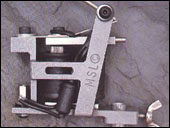
modern tattoo-machine

new generation of a
hand-held scanner
But the tattoo is widely accepted as a medium of notation by all cultures alike. Why not take this idea to its logical conclusion and incorporate it as a medium in the world of digital communication? Furthermore, using it as a means of storing coded information would invest it with a more contemporary aesthetic. Art-historically speaking, this would also mean the first "digital" tattoo ever.
Today, digital methods of processing graphic data are common enough. The current state of development means that it is possible to feed in a digital tattoo with a common hand-held scanner. However, problems may arise due to the nature of the respective person's skin as you get the best results with hand-held scanners if the surface is entirely flat and dry. Care should therefore be taken in choosing where to have one's digital tattoo. The basic idea of using skin tissue to store data aims at consistent retrievability at all times. In connection with current telecommunication technology, a variety of interesting options for mobile communication arises.